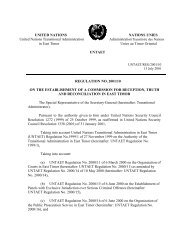The Srebrenica Massacre - Nova Srpska Politicka Misao
The Srebrenica Massacre - Nova Srpska Politicka Misao
The Srebrenica Massacre - Nova Srpska Politicka Misao
You also want an ePaper? Increase the reach of your titles
YUMPU automatically turns print PDFs into web optimized ePapers that Google loves.
Prelude to the Capture of <strong>Srebrenica</strong><br />
tinue the war as sanctions wore down the Serbs.<br />
British diplomat Cedric Thornberry, Assistant UN Secretary General,<br />
who personally investigated atrocities committed by each of the<br />
warring sides, writes: “By early 1993, a consensus developed—especially<br />
in the United States, but also in some West European countries and<br />
prominently in parts of the international liberal media—that the Serbs<br />
were the only villains, all through Yugoslavia, and that the victims were<br />
overwhelmingly or even exclusively the Croats and Muslims. This view<br />
did not correspond to the perceptions of successive senior UN personnel<br />
in touch with daily events throughout the area; as a kindly soul at<br />
the UN headquarters in New York, ear to the diplomatic grapevine,<br />
warned me, take cover—the fix is on.” 32 <strong>The</strong>se observations describe<br />
the political and military climate that developed as events were unfolding<br />
in Eastern Bosnia when <strong>Srebrenica</strong> first gained international attention<br />
in 1993.<br />
Naser Oric’s Reign of Terror<br />
Most of the world first heard of <strong>Srebrenica</strong> in March of 1993, when<br />
UN Sarajevo Commander General Philippe Morillon, acting without<br />
the approval of his superiors, made a risky visit to open a humanitarian<br />
convoy route to the city in Eastern Bosnia where fierce fighting had<br />
been taking place between the predominantly Muslim forces of the<br />
BMA and the largely Serbian BSA.<br />
Despite Morillon’s willingness to take risks to help the Muslim civilians<br />
who sought relief, the UN Commander was taken hostage by the<br />
Bosnian Muslims as a way of publicizing a humanitarian crisis to force<br />
Western military intervention. “<strong>The</strong> fact that they held me as a prisoner<br />
in <strong>Srebrenica</strong> was orchestrated in Sarajevo,” Morillon later stated<br />
in testimony at the ICTY. 33 It was <strong>Srebrenica</strong> warlord Naser Oric, Commander<br />
of the 28th Division of the BMA, who received the order to<br />
hold General Morillon as a hostage. “Naser Oric was a warlord who<br />
reigned by terror in this area and over the population itself,” Morillon<br />
observed, “[H]e could not allow himself to take prisoners. According to<br />
my recollection, he didn’t even look for an excuse.” 34<br />
General Morillon understood clearly that Naser Oric’s murderous<br />
forays against Serbian villages and numerous civilian massacres since<br />
May, 1992 were the reason that Serb military forces had blockaded Sre-<br />
46



